Thailand
The 6 Most Beautiful Temples in Bangkok
Visiting the city of Bangkok without seeing its temples is like going to a desert island without enjoying the beach… It’s (almost) pointless! These historic, cultural, but above all spiritual and sacred monuments are symbols of the capital. And there’s no shortage of choice, with no fewer than 400 religious buildings! To save you time, here’s our top 6 most beautiful temples in Bangkok that you absolutely must visit!
In summary:
The city of Bangkok is home to hundreds of temples. Here are the most beautiful and popular ones:
- Wat Pho, the Temple of the Reclining Buddha
- Wat Phra Kaew, the Temple of the Emerald Buddha at the Grand Palace
- Wat Saket, the Golden Mountain Temple
- Wat Arun, the Temple of Dawn
- Wat Traimit, the Temple of the Golden Buddha
- Wat Benchamabophit Dusitwanaram, the Marble Temple.
1. Wat Pho, the Temple of the Reclining Buddha
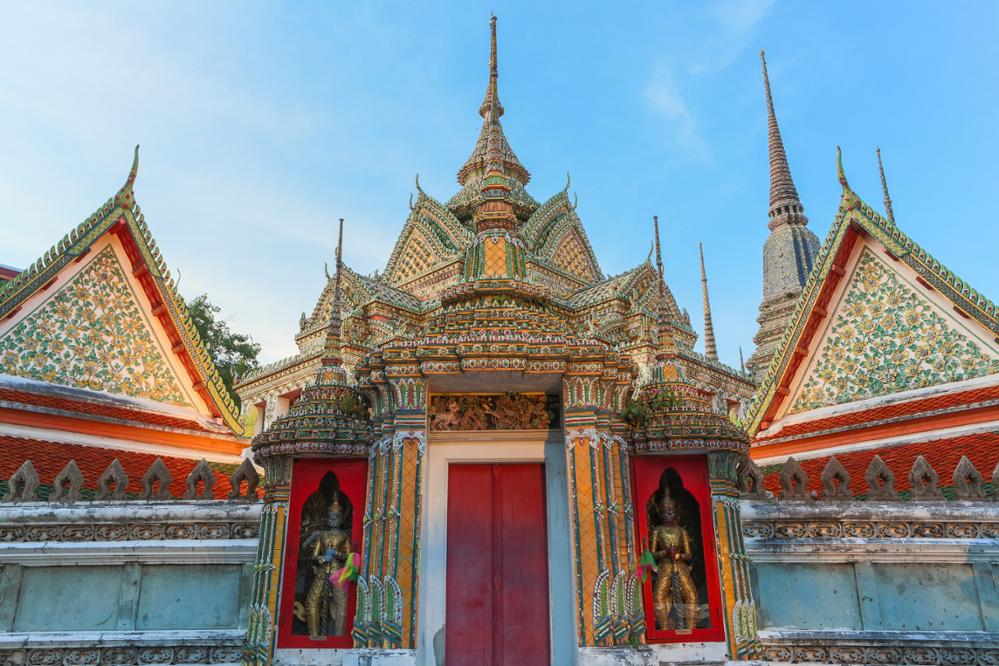
This is the largest temple in Bangkok! However, it’s famous not just for its size, but for its iconic Reclining Buddha! Measuring 45 meters long and 15 meters high, the statue of Buddha is covered in gold leaf. Its feet are inlaid with mother of pearl… Beyond the Reclining Buddha, all the temple’s pagodas are a vibrant display of colors. Especially at the end of the day when the last rays of sunlight make the thousands of stones adorning the facades sparkle.
Good to know: Wat Pho is also known for housing one of the most important schools of traditional Thai massage and medicine in the country.
Practical Information:
Address: 2 Sanamchai Road, Grand Palace Sub-district, Pranakorn District, Bangkok 10200
Hours: Daily from 8 AM to 7:30 PM
Entrance Fee*: 300 Baht per adult (foreign visitor rate). Free for children under 120 cm.
How to get there? There are several options to reach Wat Pho:
- By bus: Nos. 1, 3, 6, 9, 12, 25, 32, 44, 47, 48, 53, 82;
- By boat (Chao Phraya Express): get off at Tha Chang Pier, Tha Tien Pier, or Pak Klong Talad Pier;
- By taxi;
- By tuk-tuk.
2. Wat Phra Kaew, the Temple of the Emerald Buddha at the Grand Palace
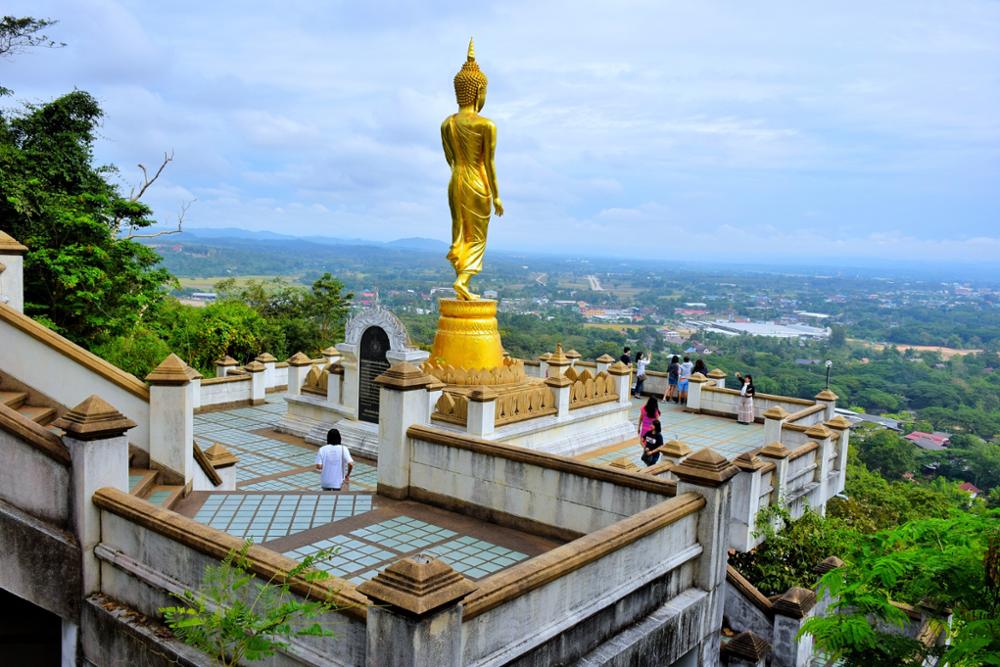
Better known as the Temple of the Emerald Buddha, Wat Phra Kaew is one of the most sacred temples in the country. It houses a magnificent Buddha carved from a block of jade dating back to the 15th century. Its origin is somewhat mysterious, but this revered Thai statue is said to have been discovered in Chiang Mai and brought to the capital in 1884. The temple is located within the Grand Palace, the royal residence, on the left bank of the Chao Phraya River.
Practical Information:
Address: Na Phra Lan Rd, Phra Borom Maha Ratchawang, Phra Nakhon, Bangkok 10200, Thailand
Hours: Daily from 8:30 AM to 4:30 PM
Entrance Fee*: 500 Baht per person (foreign visitor rate). The ticket includes access to Wat Phra Kaew and the Queen Sirikit Textile Museum, also located within the Grand Palace. Note that tickets are sold until one hour before closing, until 3:30 PM.
How to get there? There are several options to reach Wat Phra Kaew:
- By bus: Nos. 1, 3, 9, 15, 25, 30, 32, 33, 43, 44, 47, 53, 59, 64, 80, 82, 91, 203, 503, 508, 512;
- By boat (Chao Phraya Express): get off at Tha Chang Pier, Tha Tien Pier, or Pak Klong Talad Pier;
- By taxi;
- By tuk-tuk.
3. Wat Saket, the Golden Mountain Temple
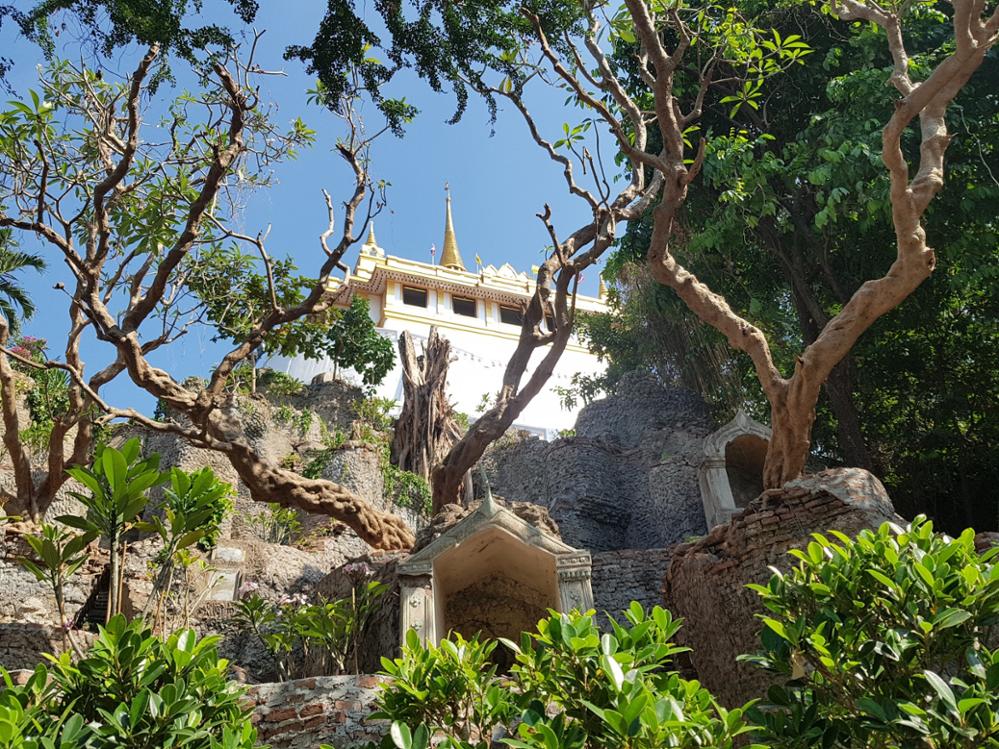
Also called the Golden Mountain Temple, Wat Saket was built on an artificial hill. The 58-meter-high Chedi is said to contain Buddha relics. To reach it, you’ll need to climb 318 steps! Along the way, you’ll encounter many animal statues in a fairy-tale-like setting. Don’t forget to ring the bells as you ascend and finish with three gongs (one to show respect to Buddha, another for Buddhism in general, and a final one for the monks). Once at the top, you’ll be rewarded with breathtaking panoramic views, one of the most beautiful in Bangkok!
Practical Information:
Address: 344 Chakkraphatdi Phong Rd, Ban Bat, Pom Prap Sattru Phai, Bangkok 10100, Thailand
Hours: Daily from 7:30 AM to 7 PM
Entrance Fee*: 100 Baht per person (foreign visitor rate).
How to get there? There are several options to reach Wat Saket
- By bus: Nos. 8, 15, 37, 47, 49;
- By boat (Chao Phraya Express): get off at Phan Fa Lilat Pier (Khlong Saen Saep) or Tha Phu Khao Thong Pier (Khlong Phadung Krung Kasem);
- By taxi;
- By tuk-tuk.
4. Wat Arun, the Temple of Dawn
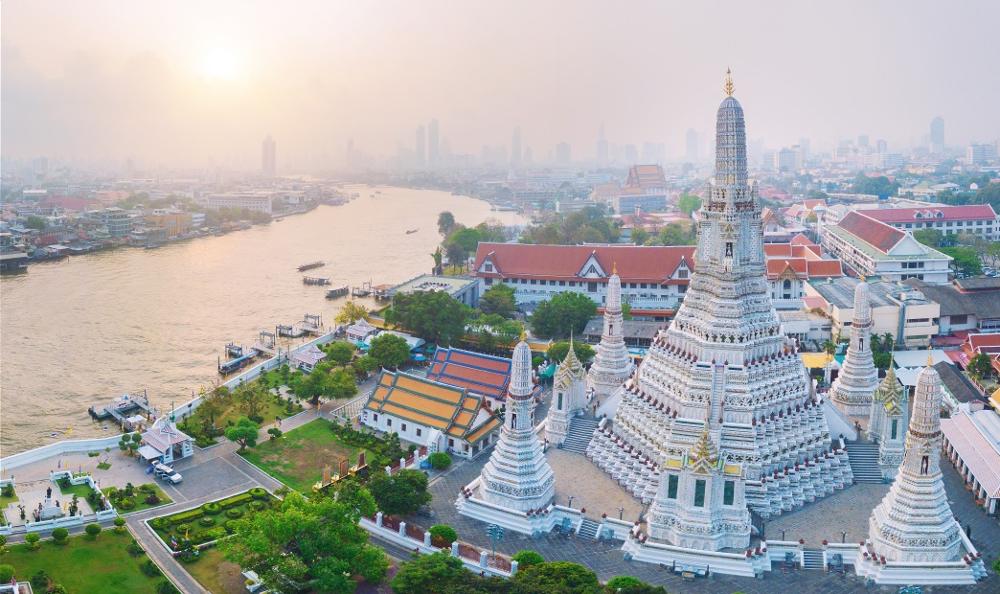
Across the river, opposite Wat Pho and the Royal Palace, stands Wat Arun. Named Aruna after the Hindu deity, it’s known as the Temple of Dawn because it is said to be the first building to receive sunlight. Its main 80-meter tower and four other prangs are covered with porcelain fragments and house statues of the wind deity (Nayu). This temple is just as impressive by day or night, when it’s illuminated and sparkles along the Chao Phraya!
Practical information:
Address: 158 Thanon Wang Doem, Wat Arun, Bangkok Yai, Bangkok 10600, Thailand
Hours: Daily from 8:30 AM to 5:30 PM
Entrance Fee: 200 Baht per person (foreign visitor rate).
How to get there? There are several options to reach Wat Arun:
- By Skytrain + boat (Chao Phraya Express): take the BTS Silom line to Saphan Taksin Station, then take the boat and get off at Tha Tien Station;
- By bus: Nos. 19, 57, and 83;
- By taxi;
- By tuk-tuk.
5. Wat Traimit, the Temple of the Golden Buddha
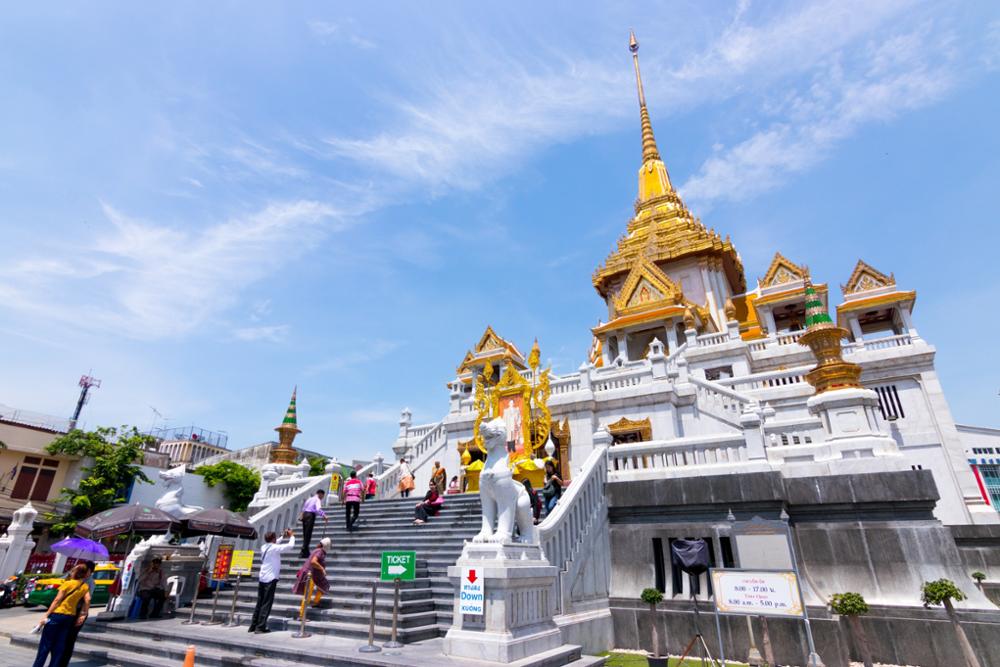
Wat Traimit might not be the most beautiful temple in Bangkok, but what makes it particularly interesting is what it holds inside: one of the world’s largest golden Buddha statues! Hence its more common name, the Temple of the Golden Buddha. According to legend, this treasure, 5 meters high and weighing 5.5 tons, was discovered by accident. In 1931, monks found a seemingly unremarkable plaster statue. When it shattered, they discovered that inside was… you guessed it, a golden statue! This incredible discovery is now on display inside the temple.
Note: The temple houses a museum on the third floor where you can learn more about the history of the Golden Buddha.
Practical information:
Address: 661 Charoen Krung Road, Talat Noi, Samphanthawong, Bangkok 10100, Thailand
Hours: Daily from 8:30 AM to 5:30 PM. The museum is closed on Mondays.
Entrance Fee: 50 Baht per person (foreign visitor rate). Museum entrance: 100 Baht per adult and 60 Baht for children.
How to get there? There are several options to reach Wat Traimit:
- By metro (MRT): get off at Hua Lamphong Station;
- By bus: Nos. 5, 7, or 507;
- By taxi;
- By tuk-tuk.
6. Wat Benchamabophit Dusitwanaram, the Marble Temple

Finally, we have a temple built at the end of the 19th and early 20th centuries under King Rama V: Wat Benchamabophit Dusitwanaram (which literally means “Temple of the Fifth King located near the Grand Dusit Palace”). Also known as the Marble Temple, it’s considered one of the most beautiful temples in Bangkok and an architectural masterpiece. You’ll find Carrara marble (which gave it its nickname) on the floors and columns, a gilded ceiling, Chinese ceramics, teak wood doors, bronze sculptures, and more… Outside, you can enjoy its perfectly manicured gardens, which exude a peaceful atmosphere.
Good to know: Inside the temple is a large Buddha statue known as Phra Buddha Niramitravichaya Chai, which houses the ashes of King Rama V, who passed away in 1910.
Practical information:
Address: 69 Thanon Si Ayutthaya, Dusit, Dusit District, Bangkok 10300, Thailand
Hours: Daily from 8 a.m to 5 p.m
Entrance Fee: 150 Baht per person (foreign visitor rate). Free entry to the garden.
How to get there? There are several options to reach Wat Benchamabophit Dusitwanaram:
- By metro (BTS): get off at Saphan Kwai Station, then walk to the temple (about 1.5 km);
- By bus: Nos. 2, 10, 12, 60, 72, and 503;
- By taxi;
- By tuk-tuk.
Other lesser-known temples to discover
Want more? Here are some other lesser-known temples worth seeing in Bangkok:
- Wat Suthat Thepwararam: A royal temple known for its impressive prayer hall, one of the largest in all of Thailand.
- Wat Ratchanadda:A Buddhist monastery housing the royal temple of Loha Prasat, characterized by a 37-spire metal structure representing the 37 virtues needed for enlightenment.
- Wat Mahathat Yuwaratrangsarit: Built during the Ayutthaya period, it is one of the 10 royal temples and houses Thailand’s oldest higher education institute for Buddhist monks.
- Wat Chana Songkhram: Known for its large seated Buddha and beautiful murals depicting excerpts from the Jatakas, stories of Buddha’s previous lives.
- Wat Bowonniwet Vihara: The residence of Nyanasamvara Suvaddhana, the former Supreme Patriarch of Thailand, and the resting place of two former kings of the Chakri dynasty: Rama VI and Rama IX.
- Wat Prayurawongsawas Worawihan:Known for housing Buddha relics within its ancient white stupa, built during the reign of King Mongkut.
- Wat Ratchapradit:Built by King Rama IV in 1864, this temple stands out with its grey architecture.
Etiquette for Visiting a Temple in Thailand
As in many cultures, it’s important to follow certain etiquette when visiting Thai temples:
- Dress respectfully: Ideally, wear a sarong (traditional Thai attire). At the very least, cover your shoulders and knees, regardless of gender. Avoid short clothes exposing the belly, see-through or tight clothing, and torn clothes.
- Remove shoes before entering temples (unless otherwise indicated);
- Never step on a Buddha image;
- Never point your feet towards Buddha statues;
- Sit respectfully:** cross-legged for men, and kneeling with Never touch a monk if you’re a woman:monks are not permitted physical contact with women. Simply greet with a bow and hands joined (known as a wai in Thailand);
- Never take photos of monks without permission;
- Do not touch anything;
- Remain silent and respectful inside temples.
*Prices are provided as a guide and may vary.
Florine Dergelet

